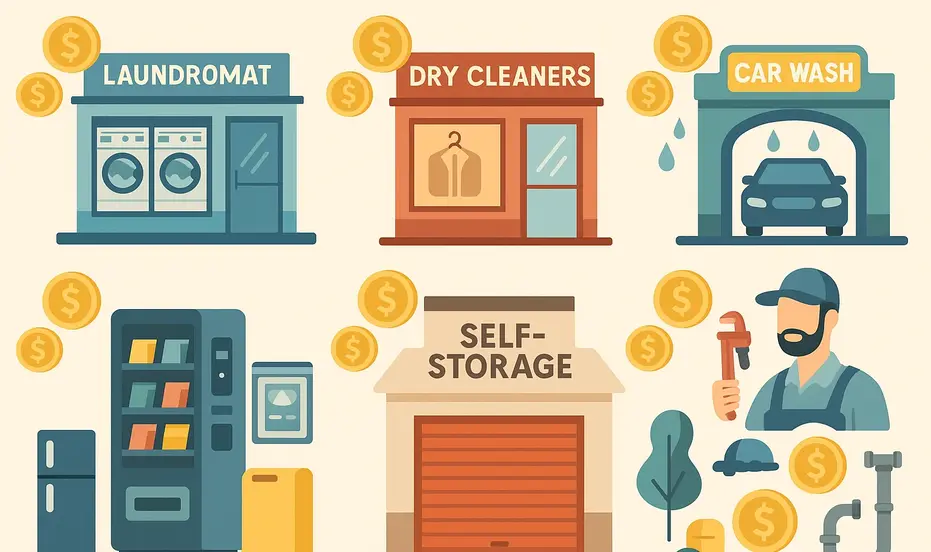Are you chasing trendy startups and flashy tech companies in your quest for financial success? You might be overlooking the most reliable path to wealth. According to successful entrepreneurs, the secret to building substantial wealth isn’t found in complicated business models or cutting-edge technology—it’s in boring, everyday businesses that most people ignore.
This comprehensive guide reveals how ordinary businesses in overlooked industries are generating extraordinary profits, with real-world examples of entrepreneurs who have built multi-million and even billion-dollar empires from the most mundane business concepts.
The Profitable Reality of Boring Businesses
The most successful entrepreneurs understand a fundamental truth: complexity rarely equals profitability. David, CEO of Filterby, an air filter company generating $22 million monthly, explains that making hundreds of millions of dollars isn’t complicated—it simply requires finding a boring business you’re willing to commit to long-term.
According to industry analysis from the Small Business Administration, businesses in “unsexy” industries often enjoy higher profit margins, lower competition, and greater stability than their trendy counterparts. These advantages create the perfect environment for sustainable wealth building.
Why Boring Businesses Outperform Trendy Startups:
- Lower customer acquisition costs: Established demand versus creating new markets
- Higher profit margins: Less competitive pressure on pricing
- Consistent cash flow: Meeting essential ongoing needs versus discretionary spending
- Lower failure rates: Proven business models versus experimental concepts
- Greater acquisition potential: Attractive targets for private equity and strategic buyers
Two Cash Flow Business Models That Generate Millions
When analyzing profitable boring businesses, they generally fall into two categories: property-oriented businesses and service-based businesses. Each offers distinct advantages and scaling opportunities.
Property-Oriented Businesses:
These businesses revolve around physical assets that generate recurring revenue. They typically require more upfront capital but can create substantial passive income streams once established.
Service-Based Businesses:
These operations focus on providing essential services to consumers or other businesses. They generally require less initial investment but depend more heavily on systems, knowledge, and human resources to scale effectively.
Property Business #1: ATM Ownership ($1,000-$100,000/Month)
One of the most overlooked cash-generating assets is the humble ATM machine. This business model exemplifies how a basic service meeting an everyday need can produce extraordinary returns.
The ATM Success Story:
Paul Alex, a retired San Francisco police officer, purchased his first ATM in 2018 for just $2,100 and installed it in a local nail salon. That single machine generated $500 monthly profit with minimal time investment. By gradually expanding to more locations, Paul built a network of over 30 ATMs by 2021, generating $10,000+ monthly profit—enough to retire from his police career.
Today, his company ATM Together earns over $8 million annually and helps others start their own ATM businesses.
Keys to Success in the ATM Business:
- Strategic location selection: High-traffic areas with limited banking access
- Reliable maintenance systems: Ensuring machines remain operational
- Cash flow management: Maintaining sufficient cash reserves
- Relationship building: Securing and maintaining profitable placement agreements
- Gradual scaling: Starting small and reinvesting profits into additional machines
According to the National ATM Council, independent ATM operators can achieve ROI within 6-14 months on properly placed machines, making this one of the fastest ways to generate positive cash flow with minimal time commitment.
Property Business #2: Laundromats (95% Success Rate)
Laundromats represent another seemingly mundane business with remarkable profit potential and stability. Industry publications report an astonishing 95% success rate for laundromat businesses—nearly double the 50% average success rate for small businesses overall.
Why Laundromats Work:
- Essential service: People always need clean clothes
- Recession-resistant: Demand remains stable regardless of economic conditions
- Semi-passive operation: Can be managed with part-time oversight
- Predictable expenses: Water, electricity, and maintenance costs are relatively stable
- Multiple revenue streams: Washing, drying, vending machines, and additional services
Critical Success Factors:
- Location quality: Proximity to apartments, colleges, and areas with limited in-home laundry facilities
- Equipment reliability: Commercial-grade machines with minimal downtime
- Facility cleanliness: Creating an environment customers trust
- Security measures: Ensuring customer safety, especially for 24-hour operations
- Capital planning: Preparing for occasional major equipment replacements
While laundromats can provide excellent cash flow, they typically require more substantial initial investment than other options on this list. However, financing options through equipment vendors and SBA loans make this more accessible than many aspiring entrepreneurs realize.
Property Business #3: Equipment Rental ($10,000+/Month)
The equipment rental business represents a perfect intersection of high demand, tax efficiency, and scalability. This model becomes particularly valuable during supply chain disruptions when businesses cannot quickly purchase needed equipment.
The Equipment Rental Opportunity:
David shares a personal experience where his manufacturing facility faced a crisis when an essential air compressor failed during COVID-related supply chain delays. A local rental company provided a diesel replacement within hours at $500 daily—an expense gladly paid to keep operations running.
This scenario plays out daily across industries, creating tremendous opportunity for equipment rental entrepreneurs.
Advantages of Equipment Rental Businesses:
- Premium pricing: Businesses will pay significant premiums for immediate access to needed equipment
- Tax efficiency: Equipment purchases provide substantial write-offs against rental income
- Growing market: Reshoring of manufacturing increases equipment demand
- Multiple industry applications: Construction, events, manufacturing, and more
- Scalable inventory: Start with a few high-demand items and expand based on market response
Strategic Considerations:
- Equipment selection: Focus on high-demand, durable items with strong ROI
- Maintenance capabilities: Ensuring equipment remains operational
- Logistics planning: Efficient delivery and pickup systems
- Market specialization: Focusing on specific industries or equipment types
- Gradual expansion: Starting with a small, focused inventory before scaling
Service Business #1: HVAC Services (Millionaire Maker)
If you’re looking for a path to millionaire status that doesn’t require a college degree, the HVAC (Heating, Ventilation, and Air Conditioning) industry offers one of the most reliable routes.
The HVAC Advantage:
David shares how he partnered with a former Goldman Sachs colleague to launch Filterby HVAC Solutions, applying service business principles to build a scalable operation. The key insight: service businesses require minimal capital but significant knowledge and systems to scale effectively.
Why HVAC Services Excel:
- Essential service: Climate control is non-negotiable for most properties
- Recurring revenue: Maintenance contracts provide predictable income
- High-value emergencies: Premium pricing for urgent repairs
- Multiple revenue streams: Installation, maintenance, repairs, and upgrades
- Trade skill barrier: Certification requirements limit competition
Path to HVAC Success:
- Trade education: Formal training or apprenticeship to master technical skills
- Local focus: Building reputation in a specific community before expanding
- Systems development: Creating repeatable processes for consistent service
- Modern marketing: Leveraging social media and digital presence while competitors rely on outdated methods
- Strategic expansion: Gradually growing service area and team size
Search for HVAC technician training programs on WhatJobs
Service Business #2: Emergency Towing ($100,000+/Month)
One of the most overlooked yet lucrative service businesses is emergency towing, particularly when specializing in commercial vehicles.
The Towing Success Story:
David recounts meeting one of the wealthiest individuals in Talladega, Alabama—an unassuming local with limited formal education who built a fortune through emergency towing services. His secret? Specializing in 18-wheeler towing along Interstate 20, where stranded truck drivers have few options and are willing to pay premium rates for rapid assistance.
The Towing Business Model:
- High margins: Emergency situations command premium pricing
- Limited competition: Specialized equipment creates barriers to entry
- Essential service: Stranded vehicles require immediate assistance
- Strategic positioning: Proximity to major transportation routes
- Scaling potential: Additional trucks and service areas create linear growth
Keys to Towing Success:
- Equipment investment: Starting with at least one reliable tow vehicle
- Strategic service area: Positioning near highways with limited competition
- Licensing and insurance: Meeting all regulatory requirements
- Driver qualification: Ensuring proper certifications for team members
- Dispatch systems: Creating efficient response protocols
While this business requires specialized equipment and qualified operators, the barriers to entry create a moat around established operations, protecting profit margins and creating sustainable competitive advantages.
Service Business #3: Waste Management ($80 Billion Industry)
Perhaps the ultimate example of turning something unappealing into extraordinary wealth is the waste management industry—an $80 billion sector that continues to grow regardless of economic conditions.
The Waste Management Success Story:
Patrick Dovigi, a former hockey player from Ontario, Canada, founded Green for Life (GFL) in 2007 by consolidating several small waste management companies. His breakthrough came in 2011 when GFL secured a Toronto trash collection contract, beating much larger competitors.
Through strategic acquisitions and operational excellence, Dovigi transformed GFL from a small local operation into a publicly-traded corporation with 20,000+ employees serving customers across North America.
Waste Management Advantages:
- Universal need: Every home and business requires waste removal
- Recurring revenue: Regular service schedules create predictable cash flow
- Contractual relationships: Long-term municipal and commercial contracts
- Acquisition opportunities: Fragmented market with many small operators
- Multiple service lines: Trash, recycling, hazardous waste, and specialized disposal
Strategic Entry Points:
- Market gap analysis: Identifying underserved niches or service days
- Regulatory navigation: Understanding local waste management requirements
- Operational efficiency: Optimizing routes and resource utilization
- Customer experience focus: Reliability and responsiveness to service issues
- Environmental compliance: Meeting increasingly stringent regulations
The Cash Flow Business Success Checklist
To maximize your chances of success in any boring business venture, follow these critical guidelines that have helped entrepreneurs like David build multi-million dollar enterprises.
1. Start Lean and Control Expenses
The foundation of profitable boring businesses isn’t revenue—it’s cost control. David shares the story of John, who started a window cleaning business with just a squeegee, bucket, and soap. By beginning with minimal overhead and personally mastering every aspect of the operation, John built a $10 million revenue business with 40% profit margins—netting $4 million annually from window cleaning.
This hands-on approach provides invaluable insights into operational pain points, enabling the development of efficient systems when scaling the business.
2. Validate Before Investing
Successful boring businesses typically have models that generate revenue quickly, but smart entrepreneurs further reduce risk through validation strategies.
David explains how he launched Filterby by initially drop-shipping products at low margins to prove his business model before investing in manufacturing capabilities. This approach allowed him to build a customer base and refine his systems with minimal risk.
Validation Strategies:
- Service businesses: Create landing pages and run targeted ads to gauge interest
- Product businesses: Start with dropshipping or pre-orders before inventory investment
- Local businesses: Offer limited services to test market response before scaling
3. Master Local Before Expanding
The most sustainable path to building a profitable boring business starts with dominating a specific local market before attempting expansion.
Domino’s Pizza exemplifies this approach, beginning in a single college town (Ann Arbor, Michigan) where the founders perfected their delivery model by understanding exactly what local students wanted. By mastering operations in one location, they created the foundation for a global empire while maintaining local relevance through neighborhood-focused franchisees.
Local Mastery Principles:
- Community understanding: Deeply knowing customer needs in a specific area
- Service refinement: Perfecting operations before geographic expansion
- Resource concentration: Focusing marketing and relationship building efforts
- Reputation development: Building strong local references and word-of-mouth
- System optimization: Creating repeatable processes based on real-world feedback
Hiring?
Post jobs in essential service industries on WhatJobs – Find qualified candidates who keep your operations running strong.
Post an Essential Role NowFAQ About Building Profitable Boring Businesses
What makes boring businesses more profitable than trendy startups?
Profitable boring businesses typically enjoy several advantages that directly impact profitability. First, they address established needs rather than creating new markets, significantly reducing customer acquisition costs. Second, these industries often face less competition, allowing for healthier profit margins without constant price pressure. Third, boring businesses typically provide essential services or products that remain in demand regardless of economic conditions, creating consistent cash flow. Finally, these businesses benefit from proven models with lower failure rates compared to experimental concepts. According to data from the Bureau of Labor Statistics, businesses in established service sectors have approximately 25% higher five-year survival rates than those in emerging technology fields.
How much capital do I need to start a profitable boring business?
Capital requirements vary significantly across boring business models, but many can be started with surprisingly modest investments. Service-based businesses like window cleaning, lawn care, or small-scale HVAC repair can begin with as little as $1,000-$5,000 in equipment and basic marketing. Property-oriented businesses typically require more upfront investment—a single ATM costs $2,000-$8,000, while laundromats may require $200,000+ for equipment and location setup. However, financing options through equipment vendors, SBA loans, and creative approaches like equipment leasing can make these businesses accessible with limited personal capital. The key is starting small, validating your model, and reinvesting profits to fund expansion rather than taking on excessive initial debt.
How long does it typically take for boring businesses to become profitable?
Profitable boring businesses often achieve profitability much faster than trendy startups because they enter established markets with proven demand. Many service-based boring businesses can generate positive cash flow within the first 1-3 months of operation. Property-based businesses typically have longer payback periods but still outperform many alternatives—ATMs often achieve ROI within 6-14 months, while laundromats typically become profitable within 12-24 months of opening. The key factor in accelerating profitability is keeping initial overhead low while focusing intensely on service quality and customer retention. Businesses that follow the lean startup principles outlined in the cash flow checklist typically reach profitability 40-60% faster than those taking on unnecessary overhead or expanding prematurely.
What are the biggest mistakes people make when starting boring businesses?
The most common mistakes in profitable boring businesses stem from misunderstanding what makes these operations successful. First, many entrepreneurs expand too quickly before mastering operations in a single location, diluting their resources and attention. Second, they often underestimate the importance of systems and processes, trying to scale without documented procedures that ensure consistent quality. Third, many fail to invest in relationship building, not recognizing that local reputation and word-of-mouth are critical growth drivers in these industries. Fourth, entrepreneurs frequently overlook the value of specialization, trying to serve everyone rather than dominating a specific niche. Finally, many become complacent about innovation, not realizing that even boring businesses must continuously improve their operations to maintain competitive advantages and healthy margins in established markets.
The path to extraordinary wealth doesn’t always involve revolutionary technology or disruptive business models. Often, the most reliable route to financial success lies in mastering the boring, essential businesses that form the backbone of our economy. By applying strategic thinking to these overlooked opportunities, entrepreneurs can build sustainable, profitable enterprises that generate substantial wealth while meeting genuine market needs.




